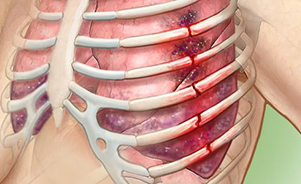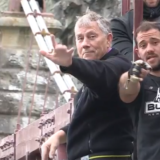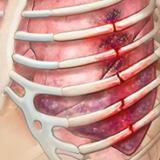Update on Chest Wall Trauma and Minimally Invasive (MIMS) Ribs Fixation

By: Ledford Powell, MD, FACS, FCCP
Each year trauma accounts for 41 million emergency department visits and 2.3 million hospital admissions across the nation. Simple rib fractures are the most common injury sustained following blunt chest trauma, accounting for more than half of thoracic injuries from nonpenetrating trauma. Approximately 10% of all patients admitted after blunt chest trauma have one or more rib fractures.
The most common mechanism of injury for rib fractures in elderly persons is a fall from height or from standing. Each year, 2.5 million older people are treated in emergency departments for fall injuries and over 700,000 patients a year are hospitalized because of a fall injury.
Motor vehicle accident is the most common mechanism in adults, and recreational activities in young adults.
Orange County has a young athletic community as well as an aging population susceptible to injuries. Rib fractures are frequent in our community. These patients present to trauma centers, the ED, urgent care and their primary care physician. Many physicians, as well as patients, are not aware of the treatment options for rib fractures.
Patients often experience pain and difficulty breathing for long periods of time after their injury and during recovery, with little to no relief from medications. Recovery from rib fractures can range from 8 -16 weeks depending on age and health of patient. Some patients experience chronic problems related to their injury.
Pain control is fundamental to the management of rib fractures to decrease chest wall splinting and alveolar collapse, which is necessary to clear pulmonary secretions. The more broken ribs a patient has, the greater the impact on their pulmonary function. (Figure 1).

(Figure 1) Illustration of broken ribs
Oral and I.V. pain medications help to control pain but may depress respiratory function. Intercostal nerve blocks provide pain relief without affecting respiratory function, Topical treatment as well as epidural catheters have also been used in the acute setting but appear to only be a short-term solution to a problem that takes weeks to months for recovery. Epidural catheters have not altered the morbidity or mortality associated with rib fractures.In the past, surgical options for the treatment of rib fractures have required large incision and long hospital stays in the past. We have developed a less invasive way to fix broken ribs. Minimally Invasive Muscle Sparing (MIMS) Rib fixation is a less invasive option for surgical treatment of rib fractures. MIMS rib fixation utilizes a video scope in the chest to reduce fractures and localize fractures. The small incision for fixation spares the muscle fibers and thus causes less pain. The fixation plate is then placed beneath the muscle and applied directly to the broken rib. Most patients will describe the difference in pain before and after surgery as “Night and Day”.
Surgical fixation of rib fractures has become a more attractive treatment option because of the immediate and long term advantages of surgery. Patients with a flail chest, which is more than one fracture over more than one rib, have seen a reduction in days on the ventilator, days in the hospital, days in the ICU, less pain and faster return to work.
This advantage has also been seen in patients without a flail chest but multiple and sometimes single rib fractures. Rib Fractures are often underestimated and overlooked. Many patients die each year from rib fractures alone after a simple fall from standing. MIMS rib fixation is a safe and effective treatment for broken ribs.
We treated a middle aged man in our hospital with four broken ribs and a collapsed lung with VATS and MIMS rib fixation (Figure 2). He had no pain after surgery and went home in 3 days. His surgery was performed through a 4 cm incision (fig 3). He returned to work in 6 days after surgery.
.jpg)
(Figure 2) CXR after ORIF of four(4) broken ribs

(Figure 3) 4 cm MIMS incision with exposed fracture with plate
The MIMS rib fixation procedure is a less invasive technique with less tissue disruption and less surgical trauma. Our data shows a much faster recovery than what has been seen with other types of procedures and most patients have little to no pain after surgery. Patients do not have to suffer with rib fractures as there are now ideal surgical treatment options as discussed in this article.




